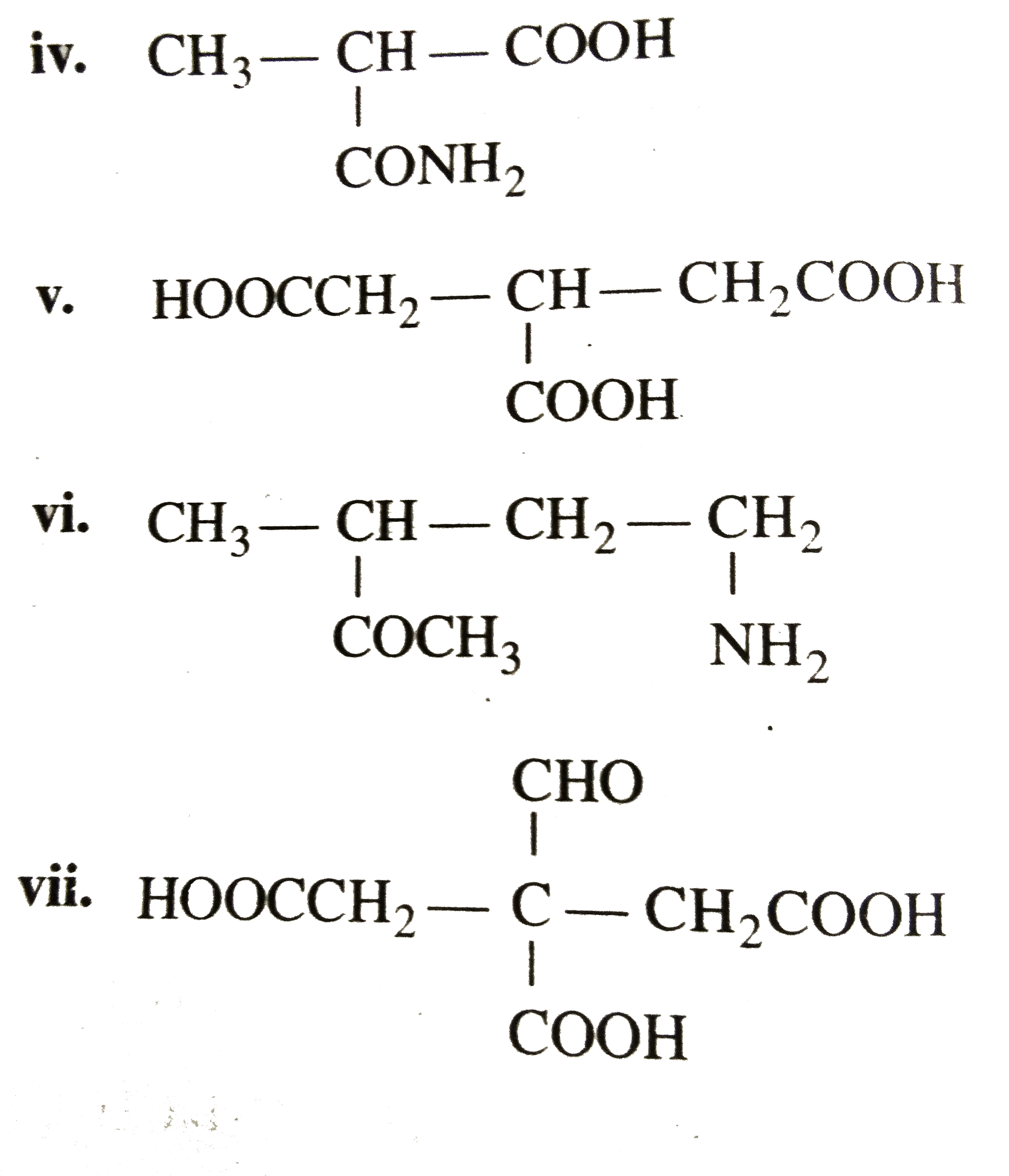The following conversion is/are possible by
The correct Answer is:A, B, C
To convert the compound Ph-CH₂-CH=O to phenylalanine (Ph-CH(CH₃)-COOH-NH₂), we can follow these steps:
Step 1: Nucleophilic Addition of Cyanide
The first step involves the nucleophilic addition of cyanide to the carbonyl group of the aldehyde. We can use potassium cyanide (KCN) in the presence of water (H₂O) for this reaction.
Reaction:
Ph-CH2-CH=O+KCN→Ph-CH2-CH(CN)
Step 2: Formation of an Amino Group
In the next step, we treat the intermediate product with ammonia (NH₃). This will lead to the addition of an amino group to the carbon that is bonded to the cyanide.
Reaction:
Ph-CH2-CH(CN)+NH3→Ph-CH2-CH(CN)(NH2)
Step 3: Hydrolysis of Nitrile
Now, we need to hydrolyze the nitrile group (CN) to a carboxylic acid (COOH). This can be achieved by treating the product with an acid (like H₃O⁺).
Reaction:
Ph-CH2-CH(CN)(NH2)+H3O+→Ph-CH2-CH(COOH)(NH2)
Final Product
The final product after hydrolysis is phenylalanine:
Ph-CH2-CH(COOH)(NH2)
Summary of Reagents
- KCN: Used for the nucleophilic addition to the carbonyl group.
- NH₃: Used to introduce the amino group.
- H₃O⁺: Used for hydrolysis of the nitrile to form the carboxylic acid.
Conclusion
The conversion of Ph-CH₂-CH=O to phenylalanine is possible using the reagents KCN, NH₃, and H₃O⁺.
---
The first step involves the nucleophilic addition of cyanide to the carbonyl group of the aldehyde. We can use potassium cyanide (KCN) in the presence of water (H₂O) for this reaction.
Ph-CH2-CH=O+KCN→Ph-CH2-CH(CN)
In the next step, we treat the intermediate product with ammonia (NH₃). This will lead to the addition of an amino group to the carbon that is bonded to the cyanide.
Ph-CH2-CH(CN)+NH3→Ph-CH2-CH(CN)(NH2)
Now, we need to hydrolyze the nitrile group (CN) to a carboxylic acid (COOH). This can be achieved by treating the product with an acid (like H₃O⁺).
Ph-CH2-CH(CN)(NH2)+H3O+→Ph-CH2-CH(COOH)(NH2)
The final product after hydrolysis is phenylalanine:
Ph-CH2-CH(COOH)(NH2)
- KCN: Used for the nucleophilic addition to the carbonyl group.
- NH₃: Used to introduce the amino group.
- H₃O⁺: Used for hydrolysis of the nitrile to form the carboxylic acid.
The conversion of Ph-CH₂-CH=O to phenylalanine is possible using the reagents KCN, NH₃, and H₃O⁺.
Topper's Solved these Questions
- CARBONYL COMPOUNDS (ALDEHYDES & KETONES ) & CARBOXYLIC ACID Book:RESONANCE ENGLISHChapter:CARBONYL COMPOUNDS (ALDEHYDES & KETONES ) & CARBOXYLIC ACID Exercise:Part -IV
Explore 23 Videos
- CARBONYL COMPOUNDS (ALDEHYDES & KETONES ) & CARBOXYLIC ACID Book:RESONANCE ENGLISHChapter:CARBONYL COMPOUNDS (ALDEHYDES & KETONES ) & CARBOXYLIC ACID Exercise:Part -II
Explore 39 Videos
- BIOMOLECULES & POLYMERBook:RESONANCE ENGLISHChapter:BIOMOLECULES & POLYMERExercise:ORGANIC CHEMISTRY(Biomolecules & Polymer)
Explore 34 Videos
- CHEMICAL KINETICSBook:RESONANCE ENGLISHChapter:CHEMICAL KINETICSExercise:PHYSICAL CHEMITRY (CHEMICAL KNIETICS & RADIOACTIVITY)
Explore 49 Videos
Similar Questions
The major product of the following equation is.
C2H5−CH3| C | Ph−CH2−CH| OH−CH3conc. H2SO4−−−−−−−→Δ
View SolutionCH3CH=CH2CO+H2O−−−−−→H+CH3−CH∣COOH−CH2
is known as:
View SolutionGive the IUPAC names for the following polyfunctional compounds:
i. CH3CH2O−CH2−CHOH−CH3
ii. CH3−C∣NO2H−CH2−CH3∣C∣OH−CH3
iii. CH2=H3C∣C−OH∣CH−CH2CN

View SolutionComplete the following reactions :
(a) Ph−CH2−CH2−OHCu/Δ−−−→, (b) Ph−CH∣OH−CH3Cu/Δ−−−→, (c) Ph−CH3∣C∣CH3−OHCu/Δ−−−→
View SolutionPredict the product from claisen condensation of the following pair of esters.
Ph−CH2−C∣∣O−OCH3+Ph−C∣∣O−OCH3EtOΘ−−−→
View Solutionname the following reactions(i). R−CH∣OH−CH2COOHNaHCO3−−−−−→ΔR−CH∣OH−CH2−H
(ii). R−CH∣NO3−CH2COOHNaHCO3−−−−−→ΔR−CH∣NO3−CH2−H
(iii) R−C∣∣O−CH2COOHΔ−−→R−C∣∣O−CH3
View SolutionWrite IUPAC name of the following compound
(a) CH3−CH2−CH∣CH3−CH2CH∣CH2−CH3−CH2−CH2−CH3
(b) CH3−CH3∣C∣CH3−CH2−CH2−CH3∣CH−CH2−CH∣CH3−CH3
(c)_S01_012_Q01.png)
View SolutionThe IUPAC name of the following is :
CH3CH=CH−CH2−CH∣NH2−CH2COOH
View SolutionThe correct order of SN2/E2 ratio for the % yield of product of the following halide is,
P.CH3−CH2−Ph∣C∣I−CH3
Q. CH3−CH∣Ph−CH∣I−CH3
R. CH3−CH2−I
S. CH3−CH−CH∣I−CH3
View SolutionWrite the IUPAC name of the following compound CH3−CH2−O∣∣C−C∣CH3H−Cl
View Solution

